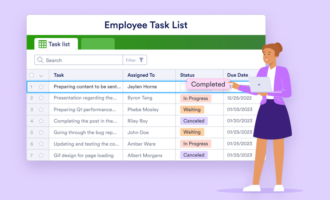Collaboration — the practice of working together toward a shared goal — is crucial for successful teamwork. Through collaboration, teams of all sizes can share ideas and develop innovative solutions.
A collaborative workspace is an environment designed to encourage that sharing and development. While the term originally refers to physical or office spaces where teams or employees can collaborate, the meaning of a collaborative workspace has expanded to include virtual workspaces.
Both physical and virtual collaborative workspaces are important if you want your team to consistently achieve goals. In this post, we’ll cover how to create this type of environment to boost team productivity and efficiency.
What are the benefits of collaborative workspaces?
Increased productivity
When people work collaboratively, they are five times more likely to perform better, according to a report by the Institute for Corporate Productivity. A collaborative workspace sets up your team for success and boosts their performance.
Faster problem solving
When professionals from different backgrounds work together in collaborative environments, they’re likely to create solutions faster because they can draw from their different skill sets and experiences.
Better company culture
Brandon Monaghan, cofounder of Miracle Brand, explains that “in collaborative workspaces, employees are able to cultivate authentic relationships, both with themselves and the company.”
Collaborative workspaces help to create a bond between coworkers, stimulate a sense of inclusiveness, and support innovative ideas.
How to create a collaborative workspace
Whether your team is working remotely or onsite in the office, there are a few key steps you can take to create an environment that encourages collaboration.
1. Establish a central communication channel
“Fostering an environment of collaboration has to start with communication,” says Rex Freiberger, CEO of Gadget Review. “Your team needs to know they have an open space to collaborate and are highly encouraged to do so.”
A centralized communication channel encourages feedback among team members and keeps everyone in the loop.
2. Build a company culture that encourages collaboration
“When it comes to creating a collaborative work environment, it’s important that all employees have a voice within the company, they feel valued and heard, and are not just task makers but a part of the culture,” says Jason Akatiff, cofounder of Boundery.
In practice, this means prioritizing internal communication and promoting core values that tie into the desired company culture.
3. Extend collaboration to physical spaces
For office spaces, it’s just as important to create conducive environments that foster communication, information sharing, and camaraderie. “A collaborative workspace means stepping away from the old-school, individual cubicles of the past, and evolving into a more inclusive, think-tank-style environment,” says Georgina Borneman-Street, CEO and director of Cobalt Blue.
Gabriel Cian, cofounder of GetEmail, explains that the best physical collaborative workspaces are the ones that have a relaxed feel, offer a variety of formations and seating options, and limit their capacity.
4. Invest in tools that facilitate collaboration
Creating a collaborative workspace is difficult without the right tools. “You need to have not only the tools (hardware and software) to collaborate, but also the training to use those tools — and the security to use them safely and share data across a secured network,” says Dan Bailey, president of Wikilawn.
The suite of tools you should choose depends on the unique needs of your team. In general, you need the right mix of communication, project management, document creation, and file-sharing tools.
Tools for creating a collaborative workspace
There’s a long list of solutions that can facilitate a collaborative workspace. As mentioned above, the right combination of tools depends on the specific needs of your organization. Below are some of the most popular tools to help you power your workspace.
1. Slack
Slack facilitates communication and collaboration for teams of all sizes. One of the most popular work tools, Slack makes it easy to create a collaborative virtual hub where your team can discuss work-related matters. Slack offers a free plan for an unlimited number of collaborators.
2. Zoom
Zoom has become a household name, largely because it’s a perfect tool for hosting online meetings of up to 1,000 people. If you’re working with remote staff or clients, Zoom is an essential tool to have.
3. Google Workspace
Google provides several free tools that help create the perfect collaborative workspace, such as Google Drive for file sharing, Google Docs for document creation, and Google Meet for team meetings.
While Google’s free plans are more than enough for most users, the paid Google Workspace offers businesses and organizations additional collaboration features, including expanded storage, business emails, and more.
4. Jotform
Jotform is a versatile form builder that makes it easy to collect and share data using visually appealing online forms. It’s useful for creating surveys for audiences of all sizes. Jotform also integrates with a lot of project management and collaboration tools, such as Slack and Trello, making it easier to collect and track data across platforms.
5. Trello
This card-based software is one of the most popular and easy-to-use project management tools. In fact, you can use Trello for anything from maintaining a personal to-do list to powering an entire engineering team. Trello’s free plan allows an unlimited number of users, but you can only create a maximum of 10 boards.
6. Asana
Asana is a mature project management tool that offers more functionality than Trello. Asana is great for keeping track of multiple interconnected projects spread across different teams. Each project has a conversation view where team members can share ideas that are specific to the project.
7. Basecamp
Basecamp is another project management favorite. In addition to core project management functionality, Basecamp also has a built-in chat function, which means you may not need additional chat software.
A collaborative workspace offers several benefits for organizations. By using the right combination of tools, you can create an environment that allows your team to perform at an optimal level.


























Send Comment: